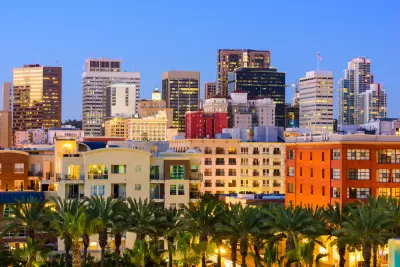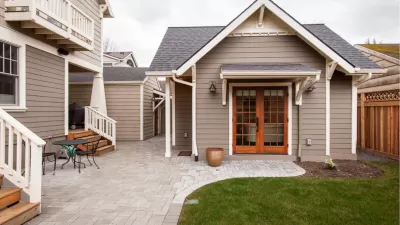A set of proposed updates to the city’s development code would expand TOD zones and encourage more backyard dwellings.

In an effort to boost housing production, San Diego officials have proposed an update to the city’s zoning rules that would expand transit-oriented development zones to a one-mile radius of a transit station and loosen regulations for accessory dwelling units (ADUs). David Garrick reports for the Del Mar Times.
Formally named the 2022 Land Development Code update, “The proposed rule changes would make an additional 5,224 acres close enough to transit to be eligible for developer density bonuses. The changes also would increase by 4,612 the acreage eligible for the accessory dwelling unit bonus program.”
As Garrick explains, “The piece of the proposal that encourages developers to build more lower-priced rental housing in prosperous neighborhoods would rely on the state’s definition of “high-opportunity” areas, which focuses primarily on the presence of educational institutions and high-paying jobs.”
The roughly 80 proposed changes also include “prohibiting new storage facilities on prime industrial land, loosening rules for pool demolitions at historic homes and specifying that converted parking lots must be used for outdoor dining, not retail.” After gaining unanimous approval from the city’s Planning Commission in December, the proposal must pass through the Land Use and Housing Committee and the full city council next month.
The city is relatively unique in that it updates its development code en masse once a year, in contrast with other municipalities that make zoning and development changes piecemeal.
See the source article for more details about proposed changes and the pushback from critics who want to preserve the current zoning code.
FULL STORY: San Diego could OK many more high-rise homes and backyard apartments under new city housing proposal

Study: Maui’s Plan to Convert Vacation Rentals to Long-Term Housing Could Cause Nearly $1 Billion Economic Loss
The plan would reduce visitor accommodation by 25,% resulting in 1,900 jobs lost.

North Texas Transit Leaders Tout Benefits of TOD for Growing Region
At a summit focused on transit-oriented development, policymakers discussed how North Texas’ expanded light rail system can serve as a tool for economic growth.

Using Old Oil and Gas Wells for Green Energy Storage
Penn State researchers have found that repurposing abandoned oil and gas wells for geothermal-assisted compressed-air energy storage can boost efficiency, reduce environmental risks, and support clean energy and job transitions.

Private Donations Propel Early Restoration of Palisades Playground
Los Angeles has secured over $1.3 million in private funding to restore the Pacific Palisades playground months ahead of schedule, creating a modern, accessible space that supports community healing after recent wildfires.

From Blight to Benefit: Early Results From California’s Equitable Cleanup Program
The Equitable Community Revitalization Grant (ECRG) program is reshaping brownfield redevelopment by prioritizing projects in low-income and environmental justice communities, emphasizing equity, transparency, and community benefits.

Planting Relief: Tackling Las Vegas Heat One Tree at a Time
Nevada Plants, a Las Vegas-based nonprofit, is combating the city’s extreme urban heat by giving away trees to residents in underserved neighborhoods, promoting shade, sustainability, and community health.
Urban Design for Planners 1: Software Tools
This six-course series explores essential urban design concepts using open source software and equips planners with the tools they need to participate fully in the urban design process.
Planning for Universal Design
Learn the tools for implementing Universal Design in planning regulations.
Ascent Environmental
Borough of Carlisle
Institute for Housing and Urban Development Studies (IHS)
City of Grandview
Harvard GSD Executive Education
Toledo-Lucas County Plan Commissions
Salt Lake City
NYU Wagner Graduate School of Public Service





























